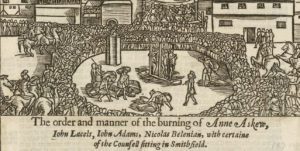I’ve been teaching a class on biblical theology and interpretation. The aim is the examine how we read and understand the Bible, how it fits together, culminates in Jesus and applies to us today. One of the key principles in biblical interpretation is that the text doesn’t say something different to us than what it said to its first hearers. That is, there’s nothing new or hidden in the text, we just need to work hard to understand it and its context.
After class one week a student said to me, “Can you tell me why it is that we need to understand the passage in its original context before we apply it to ourselves?” He wasn’t doubting that this is a good thing to do, just wanting to press deeper into why it’s the right thing. How do we know that this is how we should read the Bible?
At one level the answer seems like common sense. However, given the earnestness of the question I wanted to think a bit deeper.
The Theological Reason for Reading in Context
The philosophical and theological reason for reading in context is because the Bible is a serious and intentional text. Something written simply to entertain or amuse may not require paying attention to context in quite the same way—although the upheaval of context might be part of such a text’s ability to entertain. However, something written with a serious intention, whether to convey information or change people’s behaviour, always needs to be understood according to a context. That could be the context created by the narrative and/or a context created by the historical moment being spoken into (in the case of a letter).
The Scriptures were not written simply to record stories for their own sake nor to entertain. They were written for the purpose of changing the minds of those who read them. This is abundantly clear in certain places (for e.g. Jn 20:31). But theologically, we believe that all the words of Scripture were written by God’s Spirit for his people. They are meant to both inform us—ultimately of Jesus Christ—and change our behaviour (for e.g. 2 Tim 3:16–17; 1 Pet 1:10–11; 2 Pet 1:20–21). Yet we also know that they are human documents, not transcendent of history, but records of it and within it (e.g. Luke 1:1–4; 1 John 1:1–3). Taken together, as both a divine and human document, the word of God for us should be read according to the moments that it addresses.
The other part of my answer I’m going to share here, by way of example, is that contextual reading of the Bible has always been required. As soon as the stories of the patriarchs or the oracles of the prophets were committed to memory and subsequently to paper, those who heard it later on, always had to understand what was being said according to the previous moment being addressed. what was taking place in context.
A Narrative Example
Take for example the story of Abraham sacrificing Isaac in Genesis 22. Abraham learns a lesson about the kind of faith that the God requires and the kinds of sacrifices that God desires—the kind of sacrifice God himself ultimately provides.
So Abraham called that place The LORD Will Provide. And to this day it is said, “On the mountain of the LORD it will be provided.” (Genesis 22:14; c.f. v. 8)
Abraham himself learned the lesson through his own personal experience of these events. The record of the story however, was intended for subsequent Israelites. For Abraham, the angelic intervention (v. 12) was a matter of lived experience. For future Israelite readers this intervention could function as proof that child sacrifice (common in the Ancient Near East) is not something the LORD desires. More than that, this text conveys confidence that the “God himself will provide (v. 8). Abraham’s words were a reflection on the provision of God he was relying upon. By the time the story was written down they have become a prophetic saying waiting for fulfilment (v. 14). The intention of the text becomes clear only as we pay attention to the context of the text.
A Prophetic Text Example
Take as another example the whole of the book of the prophet Jonah. This text is narrative with a specific oracle at the centre of it (Jonah 3:4). But the book overall is an account less about the prophecy of Jonah and more about his own personal journey both physically (e.g. Jonah 1:3, 17; 3:3) and spiritually (esp. Jonah 2:7; 3:9).
Since we believe that the Scriptures are for God’s people, we believe that his journey was not written down merely as a journal entry. His story was recorded and passed on to his fellow Israelites to learn about their God, the salvation he brings to rebellious Israelites as well as his care for all humanity—even their enemies. Yet the only way that the Israelites could learn what the book was teaching them would be if they understood what the text was saying about Jonah and his journey, what he said to the Ninevites and the aftermath. The book needed to be read in context for such lessons to be learned.
A Text Sometimes Has Two or Three Contexts
What this means is that there are sometimes two or three contexts that we need to be aware of to understand a given passage. An oracle Ezekiel spoke/wrote against Tyre (Ezek 26) speaks against Tyre to be sure, but it was collected up into this book, clearly intended for the exilic community after the destruction of the temple in Jerusalem (Ezek 1:1; 33:21; 40:1). Jesus’ parables create a context within the parable itself, then they have meaning for Jesus’ hearers in the moment, and they also have a setting within each gospel narrative. A parable can itself be pointing to something beyond the moment, such as in Mark 12, where Jesus’ parable of the vineyard prophesies his death and resurrection.
Once we do the hard work of thinking through these contexts, we can be in a position to take what is written and apply it to our own moment. While the text is not saying something new or different, its application might be quite different.
Let me circle back to Abraham sacrificing Isaac and show you what I mean. For Abraham, the application of the situation was to grow in his trust in the LORD and his provision. For those Israelites who followed, they were to keep looking for God to provide and trust God wholeheartedly as Abraham did. But in our context, we live not only knowing that the LORD will provide, not only imitating Abraham’s commendable example of faith, but also knowing abundant provision has come. The Lord has provided. It turns out that the request for a “one and only son” (Gen 22:2) would eventually be provided by the Lord who would give his one only Son for the world so that we could find life in the face of death (Jn 3:16).
We read the text in its context, but we apply it in ours. We apply the Scriptures to ourselves as those on whom the end times have come.















